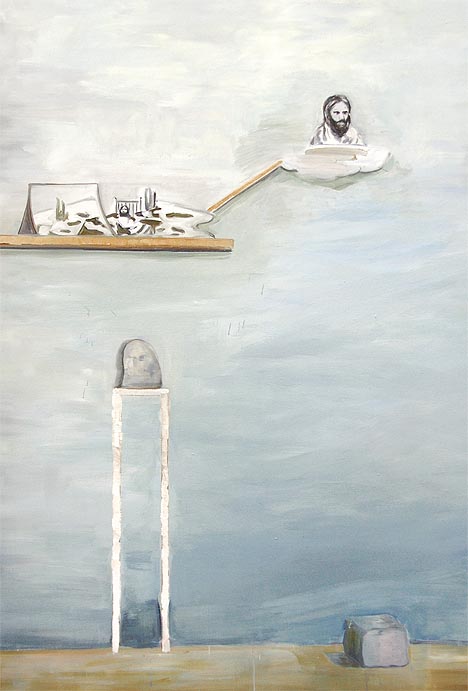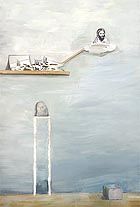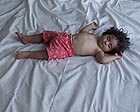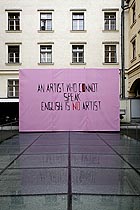
translated and summarized by: Liz Wollner-Grandville,
English summary October 20 - 27
Startgalerie im Museum auf Abruf: Christoph Holzeis – Links von der Schulter die Wolke (To the left of the shoulder the cloud)
Uncommented poetic
The title of this exhibit: “To the left of the shoulder the cloud” is taken from one of Ferdinand Schmatz’s poetical texts, which he had used to describe a painting. No wonder that all of these works appear like painted modern lyrics. The motives are always recognizable, but not clearly formulated. They seem to float in a space without any reference to anything, similar to hints, which only make sense to those who are in on a secret.
At times one allegedly believes to recognize paper pages and books in these large format paintings, but they could just as well be abstract lines or planes. The rather coarsely painted works are made using reduced colours, quasi-abstract compositions.
The works have their own poetry, which, similar to modern lyrics, does not originate from anything clearly recognizable, and seems to thrive on the aura it is surrounded by. Even though the artist has definitely found his own style, he cannot deny having worked with Schmalix. And it comes as no surprise that Christoph Holzeis studied German philology, philosophy, psychology, and pedagogy before he indulged in art. His art has a kind of theory-loaded effect.
Startgalerie im Museum auf Abruf
1010 Vienna, Felderstrasse 6-8, next to the town hall, until 07.11.2008
www.musa.at
Serpentine Gallery: Gerhard Richter – 4900 Colours: Version II
Calculated coincidence
By letting dice dictate the positioning and alignment of 49 nearly identical metal paintings, the principle of calculated coincidence follows consequently through Gerhard Richter’s complex oeuvre 4900 colours: Version II.
4900 colours was created at the same time as Richter’s glass window was unveiled last August at the Cologne Cathedral. The cathedral window is made of 11.500 blown antique-glass squares in 72 colours derived from original medieval colours. A specially developed computer program generated the seemingly coincidental colour arrangement.
Method, colour chart grids, as well as the colours themselves, form the basis for 4900 colours, made of 196 square panels, each with 25 squares. The Serpentine Gallery exhibits this work in 49 different units, each comprised of 4 panels.
The installation has some similarities to Donald Judd’s Minimalism, and one could perhaps compare John Cage’s composition methods to those of Richter.
Complementary to the colour choice and the process of production, Richter applies the principle of aleatoric coincidence (dice, computer program) and attempts to eliminate the subjectivity of painting. Benjamin H. D. Buchloh emphasizes this diagrammatical subordination of the individual aspects and talks about a quantitative regime of abstraction through methods of data collection and registry. This strategy of abstraction is in line with the tradition of the calculated coincidence in Richter’s works. The integration of digital media and industrial manufacturing methods as well as questioning abstraction and the tradition of painting constitute the consequent continuation of his artistic program. Richter on his own work: “This concept is the chance, the possibility to create paintings, which I have not made.” Yes, 4900 colours: Version II is far more than a footnote of the Cologne Cathedral window.
Serpentine Gallery
W2 3XA London, Kensington Gardens, until 16. 11. 2008
www.serpentinegallery.org
Künstlerhaus Wien: zeitraumzeit - timespacetime
Perennial culture lasts
Barbara Höller’s works deal with the structures of space in time, and of time in space. Together with Brigitte Pamperl she has curated an exhibit on this topic, in which part of the works shown were submitted by members of the Künstlerhaus and were ranked by an independent jury.
More than 70 artists display their works grouped according to themes such as spatial perception, motion, time-storage, or the universe. The works range from Wojciech Krzywoblocki’s “Painting”, Michael Höpfner’s drawings of panoramic city views, painted while he was walking, Maurice van Tellingen’s disconcerting small 3D interiors, Angelika Kaufmann’s stringent conceptual art, to Ernst Steiner’s meticulously designed geometrically structured drawings.
Even if there are some works that are weaker than others, this does not belittle the exhibit, for which, as the title already suggests, one should spare lots of time.
Künstlerhaus Wien
1010 Vienna, Karlsplatz 5, until 02. 11. 2008
www.k-haus.at
Galerie im Taxispalais: Mladen Stilinovic
Something is rotten
If money is the origin of all evil, as the placard posted in the lower hall claims, then this gallery must be the stronghold of all evil. With his installations “Money Environment” and “In God we trust”, the artist Mladen Stilinovic deals with the value of money. By referring to the words “in God we trust”, printed onto every dollar banknote, he hopes that at least the value won’t go down the drain, as was the case in the post Yugoslavian economic fiasco with the 5000-dinar notes depicting Tito’s counterfeit The current international financial crisis grants this part of the exhibit an vivid actuality, especially since Stilinovic enjoys subtracting zeros from zeros.
In the 70s Stilinovic was a member of the artist group “Sestorice Autora” which questioned the socialistic and post socialistic system in many respects. The photo series “Umjetnik radi” (= the artist at work) depicts the artist in his sleep. Laziness, as a prerequisite for intellectual work, did not at all correspond with the ideological definition of work in the socialist era.
His photo series “First of May 1975” show a banner with the words “Ado loves Stipa” (a declaration of love for his wife) wrapped around a tree and stretched across an entire road, thereby disrupting the stereotype everyday design dominant during the Tito-era.
The current socio-political misery dominating his home country is the basis for his newest works, such as the installation “Bag People”. The artist photographed people trying to sell their meagre possessions, which are all gathered in plastic bags, in a suburb of Zagreb. On the backside of the photographs he posted newspaper articles about his country’s economic instability. The installation “Open to public debate” made of labelled cardboard boxes, offers slogans used by the Yugoslav regime – and, once again everything is money-related. In “Pjevaj” (= sing!) the artist is depicted with a banknote stuck to his forehead; a common practice in Eastern Europe, aimed at motivating musicians to continue playing. At the entrance to the exhibit a video shows a frog croaking “Great show”: he is absolutely right.
Galerie im Taxispalais
6020 Innsbruck, Maria-Theresien Str. 45, until 02.11.08
www.galerieimtaxispalais.at
Mehr Texte von translated and summarized by: Liz Wollner-Grandville


 Teilen
Teilen





